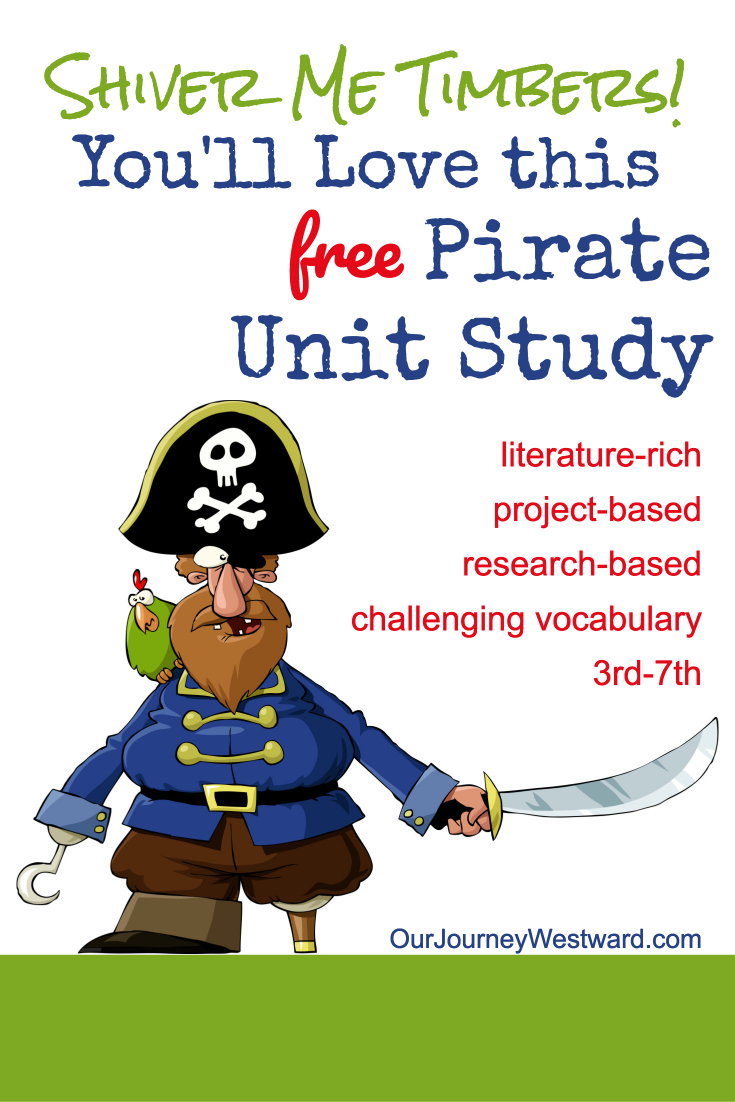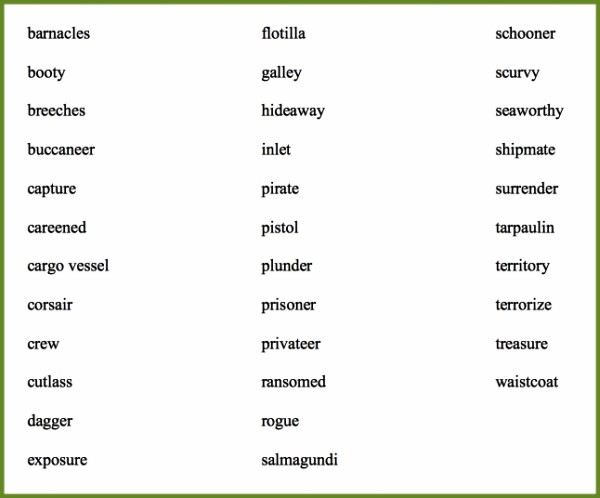Shiver Me Timbers! You’ll Love This Pirate Unit Study
Do you remember when Eli and I took a short detour from our regular Story of the World studies to learn more about Vikings? We detoured again – this time with a mini pirate unit study. Should I have been shocked? What boy (and many girls) wouldn’t love extra time to hang out with pirates?
This quick pirate unit study will give you just enough for a detailed deep dive without expecting weeks of your time.

Pirate Unit Study
One of the best things about homeschooling is the freedom to linger over a topic when it sparks curiosity. I’ve always been happy to oblige my children with learning detours, but it’s especially true with this third and final child of mine. Not only do we have a little more time to linger because it’s just the two of us, but I realize now more than ever that it’s in the lingering that so much real knowledge is often learned.
But why linger over the “golden age” of pirates—as mean and stingy as they were? Oh, there are wonderful lessons to be learned when studying pirates! Of course, pirates are a part of history, and learning about them helps children grasp a broader understanding of the dangers of exploration and settling the Americas.
You can also discuss the motivations for choosing piracy as a career option, and you might be surprised by the reasonings. Lots of world geography can be covered, too. And, not to miss, there are character discussions concerning everything from proper respect for people and their properties to decent etiquette.
Get a downloadable copy of the pirate unit study below!
This post contains affiliate links.
Pirate Books for Kids
If you’ve been around here long, you know that books are an important fixture in our homeschool. Informational, picture, and chapter books pile up no matter what we study. We don’t always read every book from the pile, but you might be surprised how many we make it through. These pirate books were in our pile this time around.
Pirates: Robbers of the High Seas by Gail Gibbons
The Best Books of Pirates by Barnaby Howard
A Year on a Pirate Ship by Elizabeth Havercroft
DK Eyewonder: Pirates by Deborah Lock
DK Eyewitness: Pirates by Richard Platt
Navigators: Pirates by Peter Chrisp
Discovering Pirates by Richard Platt
The American Boy’s Handy Book by Daniel Carter Beard
Lives of Pirates: Swashbucklers, Scoundrels (Neighbors Beware!) by Kathleen Krull
The Pirate’s Handbook: How to Become a Rouge of the High Seas by Margarette Lincoln
Sea Queens: Women Pirates Around the World by Jane Yolen
Pirate’s Promise by Clyde Robert Bulla
The Very Nearly Honorable League of Pirates by Caroline Carlson
Pirate Diary: The Journal of Jake Carpenter by Richard Platt
Treasure Island by Robert Louis Stevenson
Pirate Vocabulary
As with the Viking unit study, we still use the whiteboard for spelling and vocabulary lessons. Most of the time, the lessons look like this:
- I call out a vocabulary word, and Eli attempts to spell it using the spelling rules we learned through the Logic of English Essentials curriculum.
- I ask him what he thinks the word means. If he doesn’t know, I’ll use it in a sentence. If he still doesn’t know, he has to look it up in a dictionary (or on the internet) and then use it in his own sentence.

Pirate Unit Study Activities
When we do project-based and/or research-based learning, I typically make a large list of activities and allow him to pick and choose an assigned number. From the list below, he had to choose 10 items. Ten may seem like a lot, but some of the lesson options are really pretty easy.
Whenever I put a list like this in front of Eli, he is expected to choose various activities – a mix of easier vs. harder tasks, writing vs. non-writing assignments, and research vs. creative activities. At this point, he’s usually good about “mixing it up” on his own.
If your child is new to project-based, research-based learning, you’ll want to guide the choices until he gets the hang of it. You will present a group of three activities that are similar in goals and ask your child to choose one of the three. Then, group another set of three together and ask him to choose another. Continue in this manner until you’re happy with the workload.
You can assign all the activities at once and set a time frame for completion – a few days or more, depending on the complexity of the assignments. Or, if your children need more guidance, you can ask them to finish one assignment before moving on to the next.
Pirate Activity List
Margarette Lincoln provides detailed instructions for many of these activities in The Pirate’s Handbook: How to Become a Rouge of the High Seas.
– Research what type of clothing pirates wore. Use materials from around the house to make a pirate costume. (Art, Life Skills, History, Critical Thinking, Social Studies)
-Choose one of these famous pirates or another pirate of your choice. Write a creative report and present it orally. (Language Arts, History)
Blackbeard
Black Bart
Anne Bonny
Mary Read
Sir Francis Drake
Sir Henry Morgan
– Pirates who faced hard times often had to eat things most people would consider strange. Research what some of these things were and make a list. Would you eat them? (History, Language Arts, Life Skills, Social Studies)
– Find out what salmagundi is and make it for our family. (History, Life Skills)
– A common pirate’s food was a ship’s biscuit. Find a recipe and make a batch for our family. Be prepared to discuss why these biscuits were so common. (Math, Life Skills, Critical Thinking, Social Studies)
– Pirates often suffered from scurvy. Learn about scurvy and prepare visuals to use as you give an oral presentation. (Science, Health)
– While at sea, pirates enjoyed singing songs as entertainment. With supervision, listen to some pirate songs on YouTube. Write a pirate song to sing for the family. (Language Arts, Music, Social Studies)
– Label the continents on a blank map of the world. The famous pirate Blackbeard is thought to have had 14 wives! How many would he have if he had the same number of wives on each continent? (Geography, Math)
– Although pirates hated discipline, they had sets of rules called a code of conduct or a pirate code. Discuss with a parent what rules you think would be important on a ship. With supervision, research some of the pirates’ codes of conduct. Now, think about codes of conduct that might be important for your home and write a list of 10 – they can be serious or funny. (Language Arts, Critical Thinking, Character, Social Studies)
– What happened to pirates who broke the code? Research the answer and prepare a chart of potential disciplinary actions. (History, Language Arts, Art)
– The book Robinson Crusoe by Daniel Defoe is thought to be based on a true story and gives a detailed account of what it was like to be stranded on a deserted island. Write your own story about being stranded on a desert island. How did you get there? Who are you with? What are the conditions like? What are your adventures/challenges/triumphs? (Language Arts)
– Pirates helped spread knowledge of the world by sketching maps of coastlines. Walk around your neighborhood or a local park and map it out as accurately as possible. (Geography)
– The islands of Madagascar, New Providence, and Bias Bay were all used as hideaways for pirates, otherwise known as pirate bases. Color and label these places on a world map. (Geography)
– There are legends that pirates hid their treasures for safekeeping. While there are only a few accounts that this happened, “X marks the spot” treasure maps are popular lore. Hide a “treasure” somewhere in the house or the yard, and then make a treasure map for your siblings to use to find the treasure. (Geography, Art)
– Learn about different types of pirate ships. Write an essay about which kind you would choose and why. (History, Science, Critical Thinking, Language Arts)
– Using colored pencils, draw a picture of a schooner. (Art)
– Ships float because of something called “buoyancy.” Research to prepare a demonstration and explanation of buoyancy. (Science)
– Fill the bathtub with water and test the buoyancy of different objects (soap, marble, ball, penny, matchbox car, etc.). Make a chart of what floats and what sinks. Do your results coincide with what you learned about buoyancy? (Science)
– Using your chart from the previous activity, make a bar graph of how many objects floated and how many sank. (Math)
– Knot-tying skills are a must for any sailor- including pirates. Using a rope or clothesline, learn how to tie a roof knot, a bowline, and another knot of your choice. (Life Skills)
– Research the symbols used on pirate flags and their meanings. Make a pirate flag out of fabric, felt, or cardstock, and explain the meaning(s) to your family. (Art, History)
– With supervision, view images of pirate’s swords. Make a similar sword using cardboard and aluminum foil. (History, Art)
– Pirates who were caught and convicted often suffered terrible punishments. Find out some of these punishments and list them in your history notebook. (History)
– Use “A Ballad for Captain Kidd” as copywork. Listen to the song several times and lead a family sing-along. (History, Language Arts, Music)
– Pirates had their own language. Look up the meanings of these terms and note them in your history notebook. (Language Arts, History, Social Studies)
To go on the account
Avast ye landlubbers
Swinging the lead
Davy Jones
Walking the Plank
To be keelhauled
Sea legs
Yellow Jack
Take a caulk
Shiver me timbers
Long clothes
Tipping the black spot
An extra note for parents: Many libraries offer Mango Languages for free. Find out if yours does, and consider taking their free Pirate course. (Language Arts, Social Studies)
Printable Pirate Unit Study
For your convenience, I’ve created a quick reference to all the books, vocabulary, and activity ideas from this post! Grab the 6-page printable pirate unit study by entering your email address below.
Other posts you might like:
















Hi Cindy,
Thank you for this great Pirate Unit Study!
You are VERY welcome! 🙂
This is amazing! Thanks so much for sharing these wonderful resources. My 10-year-old daughter requested to learn about pirates. I originally thought, “How in the world do we make this educational and edifying?!” You answered all those questions perfectly. Now I’m really looking forward to a unit study on pirates!
Thanks for such a great message, LeAnn! Have fun!